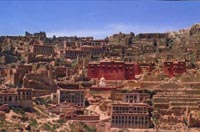| Travel in China > Protected Sites > Class Άρ > Constructions |
|
|
Ganden Monastery The Ganden Monastery is located on the south bank of the Lhasa River in Dazi County, the Tibet Autonomous Region.
Though small in scale at the very beginning, the monastery was expanded many times till its buildings prevailed all over the mountain where it is located. Originally the monastery
Structures in the monastery consist of the Main Assembly Hall (tshomchen) and Tantric colleges. The hall has 108 pillars and occupies a floor space of 1,600 square meters, capable of holding 3,300 lamas. Maitreya and Tsong Khapa are enshrined and worshiped in the hall. Left of the huge hall is a small hall, which was the numen chapel of the monastery. The chapel was built in 1416 and the fourth Panchen added a gold roof to it in 1610.
At the peak of its splendor, the Ganden Monastery had towers side by side, and halls here and there, being thriving and prosperous. Among the towers, Serdhung, a three-storeyed building which houses Tsong Khapa's and his successors' stupas, is the most famous among the early structures. Other buildings like Tri Thok Khang, which is the residence of Tsong Khapa and the successive tripas, the Great Scripture Hall, monks' dorms are famous as well. Most of the buildings that we see today have fallen into disuse. |
||||
All rights reserved. Reproduction of text for non-commercial purposes is permitted provided that both the source and author are acknowledged and a notifying email is sent to us. |
||||
 |
